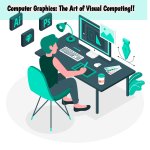Introduction to Computer Graphics
Computer graphics is a dynamic field that combines art and technology to create, manipulate, and display visual content on digital devices. From the 2D animations in early video games to photorealistic 3D environments in movies and simulations, computer graphics have transformed how we see and interact with the digital world. It is a foundational technology in entertainment, design, education, virtual reality, and even scientific research.
The Evolution of Computer Graphics
The journey of computer graphics began in the 1950s with simple line drawings on cathode-ray tube screens. Over time, advancements in hardware and algorithms enabled the rendering of more complex shapes, colors, and textures. The 1980s and 90s saw the rise of 3D graphics, used in CAD software and video games. Today, computer graphics harness powerful GPUs (Graphics Processing Units) and real-time rendering engines like Unreal Engine and Unity to create immersive and interactive experiences.
Core Components of Computer Graphics
At its heart, computer graphics can be divided into several core components:
1. Modeling
Modeling involves creating a digital representation of a 3D object. It defines the shape, structure, and geometry of the object using mathematical formulas or tools like polygons and curves. Software like Blender, Maya, and 3ds Max are popular for 3D modeling.
2. Rendering
Rendering is the process of converting models into images by simulating light, color, and texture. It can be done in real-time (as in games) or offline (as in films) using techniques like ray tracing, rasterization, and shading.
3. Animation
Animation brings static models to life. This includes character movements, environmental changes, or camera transitions. Techniques range from keyframing to physics-based simulation and motion capture.
4. Interaction
Especially important in applications like video games and VR, interaction allows users to control and influence the graphic environment through inputs such as a keyboard, mouse, or motion sensors.
Applications of Computer Graphics
Computer graphics is not limited to entertainment. It plays a critical role in many sectors:
- Film and Animation: Used in CGI (Computer-Generated Imagery) to produce lifelike characters and environments.
- Architecture and Engineering: For visualizing structures through 3D models and virtual walkthroughs.
- Healthcare: Enables 3D imaging for surgical planning and simulations.
- Education: Enhances learning through interactive visual aids and simulations.
- Scientific Visualization: Helps researchers understand complex data by transforming it into visual formats.
Future of Computer Graphics
As technology evolves, so does the potential of computer graphics. The rise of augmented reality (AR), virtual reality (VR), and artificial intelligence (AI) is shaping a new generation of visual computing. Graphics will become more immersive, realistic, and interactive, opening doors to applications we have yet to imagine.
Conclusion
Computer graphics is more than just digital artwork—it’s a powerful blend of creativity and computation. As it continues to evolve, its impact on how we work, play, learn, and communicate will only grow stronger. Whether you're an artist, engineer, gamer, or scientist, understanding computer graphics is key to unlocking the future of digital interaction.

